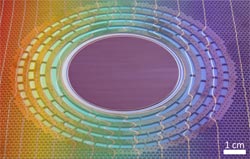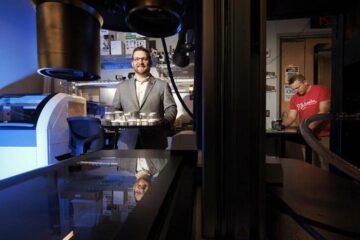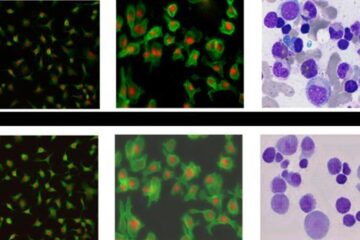Researcher Construct Invisibility Cloak for Thermal Flow

Thermal invisibility cloak: Heat is passed around the central area from the left to the right. Temperature characteristics (white lines) remain parallel. (Figure: R. Schittny/KIT)<br>
By means of special metamaterials, light and sound can be passed around objects. KIT researchers now succeeded in demonstrating that the same materials can also be used to specifically influence the propagation of heat. A structured plate of copper and silicon conducts heat around a central area without the edge being affected. The results are presented in the Physical Review Letters journal.
“For the thermal invisibility cloak, both materials have to be arranged smartly,” explains Robert Schittny from KIT, the first author of the study. Copper is a good heat conductor, while the silicon material used, called PDMS, is a bad conductor. “By providing a thin copper plate with annular silicon structures, we produce a material that conducts heat in various directions at variable speeds. In this way, the time needed for passing around a hidden object can be compensated.”
If a simple, solid metal plate is heated at the left edge, heat migrates uniformly to the right side. The temperature of the plate decreases from the left to the right. Exactly the same behavior is exhibited by the new metamaterial consisting of copper and silicon outside of the annular structure. No heat penetrates inside. Outside, there is no indication of what happens inside.
“These results impressingly reveal that transformation optics methods can be transferred to the highly different area of thermodynamics,” says Martin Wegener, Head of the Institute of Applied Physics of KIT. Here, the first three-dimensional invisibility cloak for visible light was developed. While optics and acoustics are based on the propagation of waves, heat is a measure of the unordered movement of atoms. Still, basic mathematical descriptions can be used to calculate the structures having the effect of an invisibility cloak. With the methods of so-called transformation optics, a distortion of the describing coordinate system is calculated. Arithmetically speaking, an extended object disappears in an infinitely small point. This virtual distortion can be mapped to a real metamaterial structure that passes incident light around the object to be hidden, as if it was not even existing.
“I hope that our work will be the basis of many further developments in the field of thermodynamic metamaterials,” Wegener says. Thermal invisibility cloaks are a rather new field in fundamental research. In the long term, they might be applied in areas needing effective heat management, such as in microchips, electric components, or machines.
Experiments on Transformation Thermodynamics: Molding the Flow of Heat, R. Schittny, M. Kadic, S. Guenneau, and M. Wegener, http://prl.aps.org/
Karlsruhe Institute of Technology (KIT) is a public corporation according to the legislation of the state of Baden-Württemberg. It fulfills the mission of a university and the mission of a national research center of the Helmholtz Association. Research activities focus on energy, the natural and built environment as well as on society and technology and cover the whole range extending from fundamental aspects to application. With about 9000 employees, including nearly 6000 staff members in the science and education sector, and 24000 students, KIT is one of the biggest research and education institutions in Europe. Work of KIT is based on the knowledge triangle of research, teaching, and innovation.
For further information, please contact:
Kosta Schinarakis
PKM, Themenscout
Tel.: +49 721 608-41956
Fax: +49 721 608-43568
E-Mail:schinarakis@kit.edu
Media Contact
More Information:
http://www.kit.eduAll latest news from the category: Power and Electrical Engineering
This topic covers issues related to energy generation, conversion, transportation and consumption and how the industry is addressing the challenge of energy efficiency in general.
innovations-report provides in-depth and informative reports and articles on subjects ranging from wind energy, fuel cell technology, solar energy, geothermal energy, petroleum, gas, nuclear engineering, alternative energy and energy efficiency to fusion, hydrogen and superconductor technologies.
Newest articles

Bringing bio-inspired robots to life
Nebraska researcher Eric Markvicka gets NSF CAREER Award to pursue manufacture of novel materials for soft robotics and stretchable electronics. Engineers are increasingly eager to develop robots that mimic the…

Bella moths use poison to attract mates
Scientists are closer to finding out how. Pyrrolizidine alkaloids are as bitter and toxic as they are hard to pronounce. They’re produced by several different types of plants and are…

AI tool creates ‘synthetic’ images of cells
…for enhanced microscopy analysis. Observing individual cells through microscopes can reveal a range of important cell biological phenomena that frequently play a role in human diseases, but the process of…





















